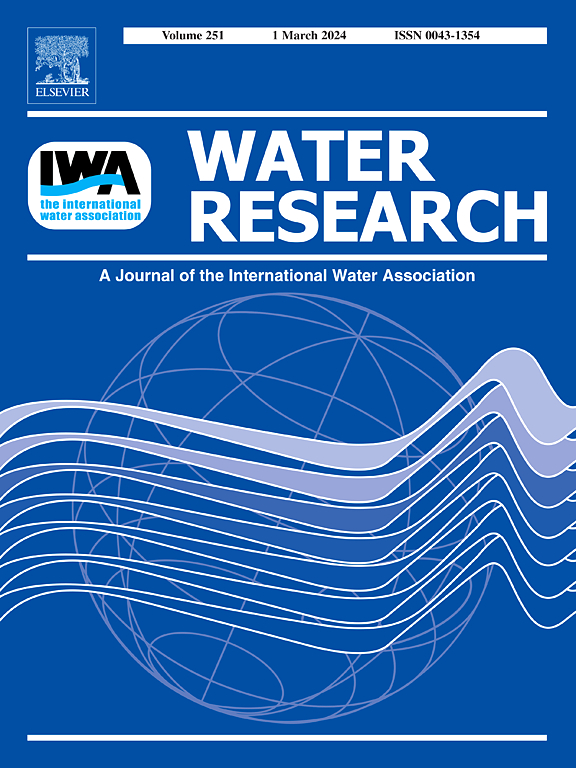光伏动力海洋电化学系统产生高氧化活性物质,同时去除海水养殖废水中的抗生素和重金属
IF 11.4
1区 环境科学与生态学
Q1 ENGINEERING, ENVIRONMENTAL
引用次数: 0
摘要
海水养殖废水含有多种污染物,如抗生素、重金属和氨氮(NH4+-N)。多种污染物的同时去除已成为一个迫切需要关注的问题。本研究采用光伏海洋电化学系统(POECs)处理海水养殖废水。poec在处理海水养殖废水中表现出优异的性能,对各种污染物的去除率分别达到98%、97.4%和95.5%。生物电化学系统(BES)和电解池(EC)的集成增强了系统的整体处理能力。这种整合导致了各种高氧化活性物质的产生,包括羟基自由基和活性氯物质(RCS)。在阳极室中,来自海洋的污泥作为生物电的来源。在纲水平上,γ变形菌和弯曲菌等功能微生物为优势种。该研究为海水养殖废水的环境友好处理提供了技术优化,具有良好的工程应用前景。本文章由计算机程序翻译,如有差异,请以英文原文为准。


A photovoltaic powered ocean-based electrochemical system produces highly oxidizing active substances for simultaneous removal of antibiotics and heavy metals from mariculture wastewater
Mariculture wastewater contains a diverse array of pollutants, such as antibiotics, heavy metals, and ammonia nitrogen (-N). The concurrent removal of multiple pollutants has emerged as an urgent problem that demands immediate attention. In this research, photovoltaic powered ocean-based electrochemical system (POECs) was employed to treat mariculture wastewater. POECs exhibited outstanding performance in the treatment of mariculture wastewater, attaining high removal rates for various pollutants: 98 % for TC, 97.4 % for Cu(II), and 95.5 % for -N. The integration of the bioelectrochemical system (BES) and the electrolytic cell (EC) augmented the overall treatment capacity of the system. This integration led to the generation of a variety of highly oxidizing active species, including hydroxyl radicals and reactive chlorine species (RCS). In the anode chamber, the ocean - sourced sludge served as a source of bioelectricity. At the class level, functional microorganisms like Gammaproteobacteria and Campylobacteria were the dominant species. The study offers technical optimization for the environmentally-friendly treatment of mariculture wastewater and holds promising prospects for engineering applications.
求助全文
通过发布文献求助,成功后即可免费获取论文全文。
去求助
来源期刊

Water Research
环境科学-工程:环境
CiteScore
20.80
自引率
9.40%
发文量
1307
审稿时长
38 days
期刊介绍:
Water Research, along with its open access companion journal Water Research X, serves as a platform for publishing original research papers covering various aspects of the science and technology related to the anthropogenic water cycle, water quality, and its management worldwide. The audience targeted by the journal comprises biologists, chemical engineers, chemists, civil engineers, environmental engineers, limnologists, and microbiologists. The scope of the journal include:
•Treatment processes for water and wastewaters (municipal, agricultural, industrial, and on-site treatment), including resource recovery and residuals management;
•Urban hydrology including sewer systems, stormwater management, and green infrastructure;
•Drinking water treatment and distribution;
•Potable and non-potable water reuse;
•Sanitation, public health, and risk assessment;
•Anaerobic digestion, solid and hazardous waste management, including source characterization and the effects and control of leachates and gaseous emissions;
•Contaminants (chemical, microbial, anthropogenic particles such as nanoparticles or microplastics) and related water quality sensing, monitoring, fate, and assessment;
•Anthropogenic impacts on inland, tidal, coastal and urban waters, focusing on surface and ground waters, and point and non-point sources of pollution;
•Environmental restoration, linked to surface water, groundwater and groundwater remediation;
•Analysis of the interfaces between sediments and water, and between water and atmosphere, focusing specifically on anthropogenic impacts;
•Mathematical modelling, systems analysis, machine learning, and beneficial use of big data related to the anthropogenic water cycle;
•Socio-economic, policy, and regulations studies.
 求助内容:
求助内容: 应助结果提醒方式:
应助结果提醒方式:


